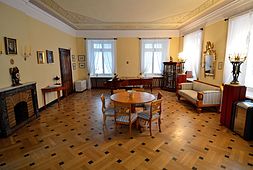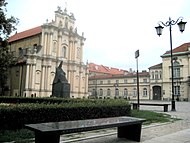Memorials to Frédéric Chopin

The following is a compilation of memorials to the composer Frédéric Chopin in the form of physical monuments and institutions and other entities named after him.
Chopin's Polish residences[]

Fryderyk Chopin's principal Polish residences survive — most of them rebuilt from the devastations of World War II — except for the Saxon Palace, where his father Mikołaj Chopin in October 1810 (when Fryderyk was six months old) took a post teaching French at the Warsaw Lyceum, housed in the Saxon Palace. The Chopin family lived on the premises.
In 1817 the Saxon Palace was requisitioned by Warsaw's Russian governor for military use, and the Warsaw Lyceum was reestablished in the Kazimierz Palace (today the rectorate of Warsaw University).[1] Fryderyk and his family moved to an extant building (center photo, below) adjacent to the Kazimierz Palace.
In 1827, soon after the death of Chopin's youngest sister Emilia, the family moved from the Warsaw University building adjacent to the Kazimierz Palace, to lodgings just across the street from the university, in the south annex of the Krasiński Palace on Krakowskie Przedmieście. Chopin lived there until he left Warsaw in 1830. The Krasiński Palace is now the Warsaw Academy of Fine Arts.
Chopin's Żelazowa Wola birthplace, and the Chopin family parlor in Warsaw's Krasiński Palace, are maintained as museums open to the public.
The Saxon Palace was destroyed by the Germans in World War II. Plans have been put forward to rebuild it. It was in the Saxon Palace (at the time, the Polish General Staff building) that civilian mathematicians working at the General Staff's Cipher Bureau, beginning in 1932, broke Germany's Enigma machine ciphers—an achievement that would be of great importance to the outcome of World War II.[2]
- Some of Chopin's Polish residences

Chopin's Żelazowa Wola birthplace. He lived here for six months in 1810.

Warsaw University building where Chopin's family lived, 1817–27, embellished (center) with his profile and (foreground) with a piano keyboard formed of flowers, June 2018
Chopin family parlor, in Warsaw's Krasiński Palace. Chopin lived here, 1827–30.
Physical monuments[]
Poland[]
- Chopin's heart, preserved in alcohol,[3] was sealed in 1882 within a pillar of the Holy Cross Church, behind a tablet carved by Leonard Marconi.[4] The tablet bears an inscription from Matthew VI:21: "For where your treasure is, there will your heart be also."[5] (See photo of the Church pillar, with epitaph.)
- The Holy Cross Church stands only a short distance from Chopin's last Warsaw residence, the Krasiński Palace, which bears a plaque commemorating Chopin.
- There are three Chopin monuments in Żelazowa Wola: an obelisk from 1894, a bronze statue from 1969 and a sandstone bust from 1984.[6]
- There is a monument to Chopin at the Szafarnia manor house where he stayed for holidays with a schoolfriend in 1824 and 1825.
- In 1897 a Chopin memorial was erected in the town of Duszniki-Zdrój, where in 1826, 16-year-old Chopin played his first concert outside of the Russian Partition of Poland. A Chopin statue was erected in 1976 and it stands in the Spa Park in front of the Fryderyk Chopin Theatre.
- In 1926 a bronze statue of Chopin, designed by sculptor Wacław Szymanowski in 1907, was erected in the upper part of Warsaw's Royal Baths (Łazienki) Park.
- Other statues and busts of Chopin stand in Poznań (1923), Wrocław (2004), Żychlin (2010),[7] Antonin, Brdów, Radziejowice, Międzyzdroje,[8] Bydgoszcz (ca. 1973), Słupsk (1976), Ustka (1979), Kraków (2005).
- For the 2010 bicentennial of Chopin's birth, 14 "Chopin's Warsaw" ("Warszawa Chopina") benches were placed in Warsaw near Chopin landmarks. They stand near Chopin landmarks such as the Krasiński Palace, the Carmelite Church where he played organ as a boy, and the Wessel Palace where in 1830 he boarded a stage for Vienna. Pressing a button on a bench makes it play a few bars of a Chopin composition.[9]
- Memorial plaques in Warsaw (numerous), Antonin (commemorating two visits to the Radziwiłł Palace), Toruń (commemorating a visit in 1825), Kalisz (commemorating visits in years 1826-1830),[10] Sanniki (commemorating a visit in 1828),[11] Sulechów (commemorating a visit in 1828),[12] Silna (commemorating a visit in 1828),[13] Wrocław (commemorating a concert in 1830), Poznań (on the courtyard of the Poznań Society of Friends of Learning).[14]
- Monument in Poturzyn, commemorating a visit in 1830 (1985).
- Memorial stones in Kozłowo (commemorating a visit in 1825),[15] Waplewo Wielkie (commemorating a visit and concert in 1827) and Strzyżew.[16]
- In 2007, a bronze bust of Frédéric Chopin, the patron of the Polish Baltic Philharmonic, by sculptor Gennady Jerszow was placed in the Philharmonic in Gdańsk.
- Obelisks in the Chopin Park in Gliwice (1949) and in Sochaczew (2010).[17]
- Chopin monuments and memorials in Poland
Funerary monument on a pillar in Holy Cross Church, Warsaw, enclosing Chopin's heart (just above bouquet at bottom)

General Dominik Dziewanowski's Szafarnia manor (with Chopin's bust in front) where Chopin vacationed in 1824 and 1825; now a Chopin Center

Chopin obelisk, Żelazowa Wola
Chopin memorial from 1897, Duszniki-Zdrój

Chopin statue, Łazienki Park, Warsaw
Bust, Chopin Park, Poznań

Obelisk, Chopin Park, Gliwice

Bust Fryderyk Chopin by Gennady Jerszow. Polish Baltic F.Chopin Philharmonic in Gdańsk 2007
Plaque (placed in 2010, on Chopin's 200th birth anniversary) commemorating the 8-year-old's first public performance, in today's Presidential Palace, Warsaw, for the Warsaw Philanthropic Society, 24 February 1818
"Chopin's Warsaw" bench near the Carmelite Church.
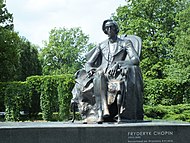
Monument, South Park, Wrocław
Europe[]
- France: Chopin's tombstone in Père Lachaise Cemetery, Paris, featuring the muse of music, Euterpe, weeping over a broken lyre, was designed and sculpted by Auguste Clésinger. Monuments to Chopin can also be found in Paris's Parc Monceau (1906) and Jardin du Luxembourg.[18] Also the Salon Frédéric Chopin at the Polish Library in Paris.
- United Kingdom: monument and blue plaques in London, monument in Manchester,[19] memorial plaques in Edinburgh and Glasgow
- Spain: busts in Valldemossa and Palma de Mallorca, memorial plaque in Barcelona
- Germany: statue in Munich's Dichtergarten, memorial plaque in Dresden, bust in Berlin's Hackesche Höfe
- Albania: bust in Tirana
- Hungary: monument in Gödöllő, bust in Budapest
- Serbia: bust in Belgrade
- Portugal: bust in Lisbon
- Netherlands: bust in Culemborg
- Czech Republic: memorial plaques in Prague and Mariánské Lázně[20]
- Austria: memorial plaque in Vienna
- Ukraine: tenement house relief in Lviv, memorial plaque in Lutsk
- Russia: bust in Kaliningrad
- Chopin monuments and memorials in Europe

Plaque, Prague, Czech Republic, where Chopin lived 1829-30

Plaque, Vienna, Austria, where Chopin lived 1830-31

Plaque, Dresden, Saxony, where Chopin stayed 1835

Bust, Valldemossa, Majorca, where Chopin stayed 1838-39
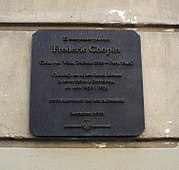
Plaque, Barcelona, Spain, commemorating Chopin's 1838 and 1839 visits
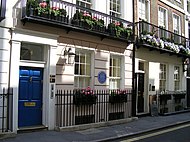
4 St. James's Place, London, whence on 16 November 1848 Chopin went to the Guildhall to give his last public performance

Hôtel Baudard de Saint-James (12 place Vendôme), Paris, where in 1849 Chopin died

Plaque on Hôtel Baudard de Saint-James, commemorating Chopin's death there
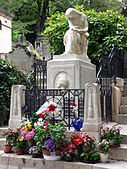
Chopin's grave, Père Lachaise Cemetery, Paris

Monument, Parc Monceau, Paris
Monument, Gödöllő, Hungary
Bust, Culemborg, Netherlands
North America[]
- The Chopin Theatre, Chopin Park, Chopin School, and Chopin Plaza,[21] all in Chicago, are named in the composer's honor – testimony to the influence of Chicago's Polish Community. A Chopin statue is planned for Chicago's lakefront.[22]
- San José, Costa Rica[23]
- Guadalajara, Mexico[24]
Asia[]

South America[]
Musical homage[]
- Sergei Lyapunov, Żelazowa Wola, Op. 37, a symphonic poem composed in 1909 to commemorate Chopin's birth centenary the following year.
Musical institutions[]

- The largest Polish music conservatory is named Fryderyk Chopin University of Music.
- The world's oldest monographic music competition, the International Chopin Piano Competition, founded in 1927, is held every five years in Warsaw. Periodically the Grand prix du disque de F. Chopin is awarded for notable Chopin recordings.
- The Chopin Festival, founded in 1946, is held annually in the Fryderyk Chopin Theatre in Duszniki-Zdrój.
Chopin societies[]
Museums[]

- The Fryderyk Chopin Museum, established in 1954, is housed in Warsaw's Ostrogski Palace, seat of the Fryderyk Chopin Society. The Museum was refurbished in 2010 for the 200th anniversary of Chopin's birth.
- Chopin's Birthplace in Żelazowa Wola is operated as a museum by the Fryderyk Chopin Museum.
- The Museum also maintains the Chopin Family Drawing Room in the Krasiński Palace, Warsaw.
- Salon Frédéric Chopin, Paris
- Cell no. 4, Valldemossa Charterhouse, Majorca - the rooms where Chopin and George Sand stayed are laid out as a museum, including Chopin's Pleyel piano.
- The Polish Library in Paris houses a permanent exhibition, the only one in France, dedicated to the composer.[26]
Other[]
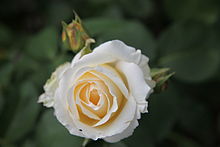
Named for the composer are:
- Warsaw Chopin Airport
- the Chopin crater on Mercury
- asteroid 3784 Chopin.
- Rose "Chopin"
Notes[]
- ^ [1] Fryderyk Chopin Information Centre.
- ^ Harry Hinsley, "The Influence of ULTRA in the Second World War" (transcript of a lecture given on 19 October 1993 at Cambridge University), 1996 [2].
- ^ Samson (1996), 193.
- ^ Holy Cross Church (Kościół Św. Krzyża) on Inyourpocket.com website, accessed 7.12.2013
- ^ Zdzisław Jachimecki, "Chopin, Fryderyk Franciszek", Polski słownik biograficzny, vol. 3, Kraków, Polska Akademia Umiejętności, 1937, pp. 424–25.
- ^ "Fryderyk Chopin - Centrum Informacji - Żelazowa Wola - Polska Chopina".
- ^ "Fryderyk Chopin".
- ^ "Międzyzdroje - Pomnik Chopina. Atrakcje turystyczne Międzyzdrojów. Ciekawe miejsca Międzyzdrojów".
- ^ "Walking Around Chopin's Warsaw (Chopin's Benches)", Visit Chopin in Warsaw website, accessed 6 August 2013.
- ^ "KALISZ: Tablica upamietniająca pobyt Fryderyka Chopina".
- ^ "Fryderyk Chopin".
- ^ "Polska Times - Wiadomości Polska".
- ^ "Pszczew i Silna".
- ^ [3]
- ^ "Geocaching - the Official Global GPS Cache Hunt Site".
- ^ "Fryderyk Chopin".
- ^ "Strony Urzędu Miasta Sochaczew".
- ^ a b c d http://bazawiedzy.chopin2010.pl/en/places/chopin-locations-today/world.html
- ^ "Unveiling Chopin Monument at Manchester Sept 2011".
- ^ "Mariańskie Łaźnie. Fryderyk Chopin w czeskim kurorcie - Otwarty Przewodnik Krajoznawczy".
- ^ "Archived copy". Archived from the original on 2014-12-19. Retrieved 2014-11-21.
{{cite web}}: CS1 maint: archived copy as title (link) - ^ http://www.chopinmonumentinchicago.com/index.php
- ^ Trochimczyk, Maja (26 January 2016). "Chopin Monuments Around the World III - From America to Asteroids". meakultura.pl. Retrieved 11 September 2020.
bust of Chopin is placed in front of the National Theater
- ^ "News". Poland. Polish Interpress Agency: 50. 1965. Retrieved 12 September 2020.
The monument is the work of Ludwika Kraskowska-Nitschowa
- ^ a b c d "Exploring South America". Warsaw Voice. 3 July 2003. Retrieved 24 January 2015.
- ^ Website of the Bibliothèque Polonaise de Paris (in French).
| Wikimedia Commons has media related to Monuments and memorials to Frédéric Chopin. |
Sources[]
- Samson, Jim (1996). Chopin. Oxford: Oxford University Press. ISBN 978-0-19-816703-7.
- Classical music lists
- Monuments and memorials to Frédéric Chopin


